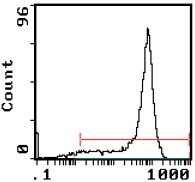Cd8a Rat Monoclonal Antibody [Clone ID: YTS169.4]
Specifications
| Product Data | |
| Clone Name | YTS169.4 |
| Applications | FC |
| Recommended Dilution | Flow Cytometry Analysis (see Protocols). |
| Reactivities | Mouse |
| Host | Rat |
| Isotype | IgG2b |
| Clonality | Monoclonal |
| Immunogen | Murine thymocytes Donor: (LOU X DA) F1 rats Fusion Partner: Myeloma Y3/Ag 1.2.3 |
| Specificity | This anti-mouse CD8a (Ly 2) monoclonal antibody reacts with a protein of approximately 30 kDa found on mouse thymocytes and mouse cytotoxic/ suppressor T cells. It does not bind to mouse helper/inducer T cells. It binds to T lymphocytes from all mouse strains regardless of phenotypic expression (i.e. reacts with T lymphocytes from mouse strains expressing the Ly 2.1 or Ly 2.2 phenotype). It can be used to investigate the role of T cells in models for infectious disease, autoimmunity, transplantation tolerance and fundamental aspects of immunology. |
| Formulation | PBS, 0.02% Sodium Azide and EIA grade BSA as a stabilizing protein to bring total protein concentration to 4-5 mg/ml Label: Biotin State: Liquid purified IgG fraction |
| Concentration | 0.1 mg/ml |
| Purification | Protein G Chromatography |
| Conjugation | Biotin |
| Database Link | |
| Background | The CD8 antigen is a cell surface glycoprotein found on most cytotoxic T lymphocytes that mediates efficient cell to cell interactions within the immune system. The CD8 antigen, acting as a coreceptor, and the T cell receptor on the T lymphocyte recognize antigen displayed by an antigen presenting cell (APC) in the context of class I MHC molecules. The functional coreceptor is either a homodimer composed of two alpha chains, or a heterodimer composed of one alpha and one beta chain. Both alpha and beta chains share significant homology to immunoglobulin variable light chains. |
| Synonyms | CD8 alpha chain, CD8A, MAL |
| Note | Protocol: FLOW CYTOMETRY ANALYSIS: Method: 1. Prepare a cell suspension in media A. For cell preparations, deplete the red blood cell population with Lympholyte®-M cell separation medium. 2. Wash 2 times. 3. Resuspend the cells to a concentration of 2x10e7 cells/ml in media A. Add 50 µl of this suspension to each tube (each tube will then contain 1 x 10e6 cells, representing 1 test). 4. To each tube, add 0.1-0.2 µg* of this Ab per 10e6 cells. 5. Vortex the tubes to ensure thorough mixing of antibody and cells. 6. Incubate the tubes for 30 minutes at 4°C. 7. Wash 2 times at 4°C. 8. Add 100 µl of secondary antibody (Streptavidin-FITC) at a 1:500 dilution. 9. Incubate tubes at 4°C for 30 - 60 minutes (It is recommended that tubes are protected from light since most fluorochromes are light sensitive). 10. Wash 2 times at 4°C. 11. Resuspend the cell pellet in 50 µl ice cold media B. 12. Transfer to suitable tubes for flow cytometric analysis containing 15 µl of propidium iodide at 0.5 mg/ml in PBS. The stains dead cells by intercalating in DNA. Media: A. Phosphate buffered saline (pH 7.2) + 5% normal serum of host species + sodium azide (100 µl of 2M sodium azide in 100 mls). B. Phosphate buffered saline (pH 7.2) + 0.5% Bovine serum albumin + sodium azide (100 µl of 2M sodium azide in 100 mls). Results - Tissue Distribution Mouse Strain: BALB/c Cell Concentration: 1x10e6 cells per tests Antibody Concentration Used: 0.2 µg/10e6 cells Isotypic Control: Biotin Rat IgG2b Results - Strain Distribution Cell Concentration: 1x10e6 cells per tests Antibody Concentration Used: 0.2 µg/10e6 cells Strains Tested: BALB/c, CBA/J, C3H/He,C57BL/6 Positive: BALB/c, CBA/J, C3H/He,C57BL/6 Negative: none |
| Reference Data | |
Documents
| Product Manuals |
| FAQs |
| SDS |
{0} Product Review(s)
0 Product Review(s)
Submit review
Be the first one to submit a review
Product Citations
*Delivery time may vary from web posted schedule. Occasional delays may occur due to unforeseen
complexities in the preparation of your product. International customers may expect an additional 1-2 weeks
in shipping.






























































































































































































































































 Germany
Germany
 Japan
Japan
 United Kingdom
United Kingdom
 China
China



